The first guitars with P90 pickups were post-war Gibson models in the late 1940s. They were designed to rival Fender’s single-coil pickups, but thanks to their middle-ground tone which straddles the line between single-coil and humbucker tones, they found their own devoted fanbase. Eventually, they became extremely popular on the punk scene and, fittingly, have always been the outsider when it comes to the main pickup types.
Fortunately for the guitar-buying public, there’s been massive resurgence of P90 guitars over the last 10 years or so. As ever, several big-name brands introduced easy-playing, lower-line models with pared back specs to attract new customers who might otherwise not take a chance on a type of guitar they’ve never played.
That’s why we’ve picked seven of our favorite P90-equipped guitars for this KillerGuitarRigs Review. As always, we’ve based our selection on build quality, tone, playability, and features, and included a wide range of options to suit every budget and ability level.
If you’ve been thinking of giving a P90 guitar a go, you won’t want to miss this!
Read more about our review process.
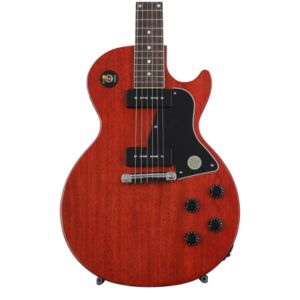
Gibson Les Paul Special
Features: Twin P90 pickups, Orange drop capacitors, PLEK'd frets
Benefits: Incredibly consistent tone, Amazing fret feel, Gnarly P90 tone
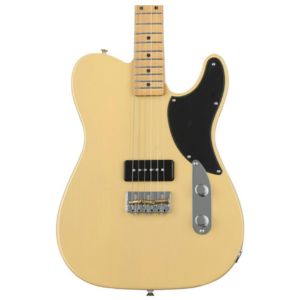
Fender Noventa Telecaster
Features:Bridge mounted P90, Slim '60s neck, Alder body
Benefits:Excellent sustain, Chunky mids, Superb responsiveness
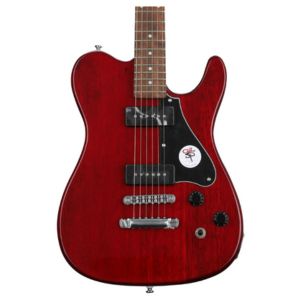
G&L Tribute ASAT Junior II
Features: Paul Gagon Designed P90s, Matched output pickups, Mahogany body
Benefits: Incredible warmth, Smooth lead to rhythm changeover, Classic P90 bark and growl
Contents
Our Top 3
Our Top Pick was the Fender Noventa Telecaster. This is a more unorthodox choice given that the Telecaster is pretty synonymous with being fitted with a pair of Fender single-coil pickups, but when loaded with a single bridge-mounted P90, it simply just works. It has a minimalist design, and still has enough in the way of embellishments to stand out.
Rock tones, raw output, and P90s done right. The G&L ASAT Junior II is cost-effective, easy-playing, and reasonably versatile. It’s truly a punk rock guitar – one that comes at you with strong mids and bags of attitude. While it isn’t dirt cheap, it’s still priced competitively enough to be the Best Budget option in the P90 category.
Our Editor’s Choice, the Gibson Les Paul Special has been in production through 8 decades and it truly is the poster child for the P90. It’s a simple instrument for players who want all the tone without the fuss and frills. While it’s one of the most expensive options in our roundup, it really is an investment piece.
Individual Reviews
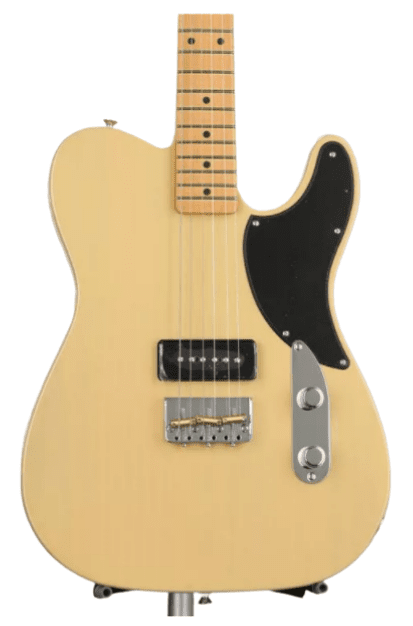
Fender Noventa Telecaster
A modern take on the guitar that started it all.
If you love classic aesthetics, but you want a more modern bite to your tone, this Tele delivers everythign and then some. With a Single bridge mounted P90, you're getting unadulterated simplicity and unmistakable tones.
The Noventa Telecaster, our top pick, ranked ahead of the Noventa Strat and Jazzmaster because it’s an exceptional stripped-down rock machine. With two knobs, one pickup, and a half pickguard. The Noventa Tele looks minimal but sounds fantastic.
It featured an alder body with a bolt-on maple neck with a 9.5″ radius. The fingerboard was made from Pau Ferro and housed 21 medium jumbo frets with dot inlays. The C-profile 60s neck was slim and playable, and the alder tonewood delivered bright and balanced tones.
It served up all the quintessential mid-rich P-90 tones. From punchy overdrive to chiming clean tones, we got some some stellar sounds from the responsive pickups and found that they had excellent touch sensitivity. It sounded great for rock, blues, country, and punk thanks to the enhanced midrange. Even so, the guitar didn’t stray too far from the ‘Fender sound’ thanks to its snappy and brighter-than-usual P90-meets-Tele tone.
The guitar also featured a “cut” bridge with 3 brass barrels designed expressly for the Noventa edition. It’s available in three finish options: 2-color Sunburst, Vintage Blond, and Fiesta Red. Ultimately, it delivered everything we expected from a soon-to-be cult classic. It even came with a nice Fender gig bag.
Verdict: Fender scores another big hit with the Noventa Series. The Telecaster with P90s is ideal for anyone who prefers punch ‘n’ crunch from a plug-and-play guitar. The price-tag is a little rich, but the Noventa Tele is a good reminder of why the world has a hard time getting past Fender Guitars.
G&L Tribute Series ASAT Junior II – Best Budget Option
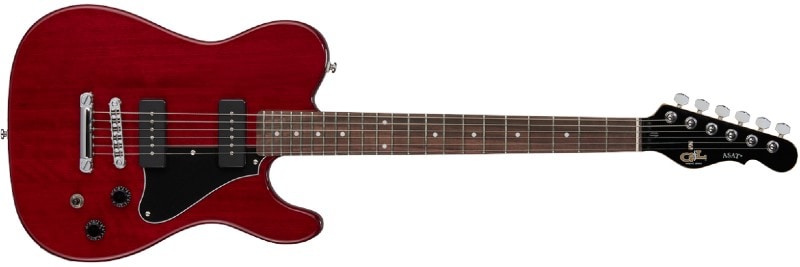
The G&L ASAT Deluxe II featured a mahogany slab body with a hard maple neck and a C-profile neck with a 12” radius. The neck featured a Brazilian Cherry fretboard with 22 medium-jumbo frets. Other notable features included a TonePros bridge/tailpiece, adjustable truss rod, and sealed-back tuners.
While it looks a lot like a single-cutaway Tele, it landed closer to a Les Paul Junior in terms of tone. The electronics comprised of two P-90s, a 3-way toggle switch, and two knobs for volume/tone. The G&L P90s delivered great sustain and well-rounded tones. There was also some additional bite thanks to the maple neck.
The guitar really is a plug-and-play rock machine, with a distinctly throaty and raw sound when overdriven. It wouldn’t be our first choice for jazz, but it can quack through blues, country, and rockabilly with ease.
You can think of it as an alternative to the Les Paul Junior or Special, especially if you don’t like the Gibson-style fat 50s neck-profile.
Verdict: The G&L ASAT Junior II is a stripped-down rock machine. It’s not a guitar with a ton of embellishments, but it’s comfortable, playable, and affordable. It’s easy to get dial in a good tone – one that sounds excellent for the price. You may buy it because of a limited budget, but there’s a good chance it’ll turn out to be a keeper.
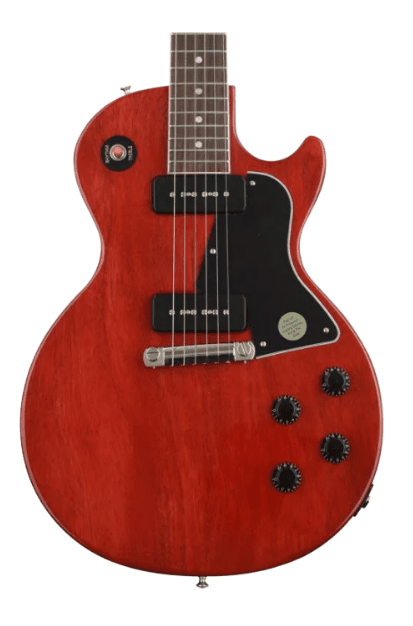
Gibson Les Paul Special
Massive P90 snarl and unparalleled build quality.
When asked to name a guitar with P90s, 9 out of 10 will say the Gibson Les Paul Special. It nets brighter tones than a guitar with humbuckers, but handles grit better than the majority of single coils - some would say it's the perfect middle ground.
The Gibson Les Paul Special is, well – special – because it’s one of the models that made Gibson relevant. It’s a classic from Gibson’s Golden Era, and seventy years later it’s still every bit as appealing.
It had a mahogany slab body, with a vintage ’50s mahogany neck and a 22-fret rosewood fingerboard. The 24.75-inch scale length may feel familiar to Epiphone/Gibson fans, and the 12″ 50s neck is chunky, just as a vintage Les Paul neck should be.
One of the benefits of buying a high-end guitar like this are the accessories. Gibson had thrown in a hard-shell case amongst other items, something we didn’t find in any of the other products in the roundup. Some of the notable features included hand-wired orange drop capacitors, vintage deluxe tuning machines, and a wraparound bridge.
The LP Special sounded fantastic and played like a dream. It was fitted with two Gibson P-90s and a control panel featuring a 3-way selector and volume/tone knobs. The soapbars were responsive, dynamic, and fully capable of cutting through any mix. Plus, there was ample sustain and a noticeable warmth thanks to the mahogany body.
From mid-heavy lead tones to cleans with reigned in brightness, it’s unlike anything else when pushed hard into overdrive – especially through a Marshall tube amp. The cleans were equally impressive and the mid emphasis is a step above the others in this segment.
Verdict: Gibson started the P90 mania with the ’50s Les Paul and they still reign supreme. Rock, blues, jazz, or indie/punk – the Gibson Les Paul Special is where it’s at. Despite its huge neck, it offers amazing playability and feel, and we can all but guarantee it’ll turn heads wherever you take it.
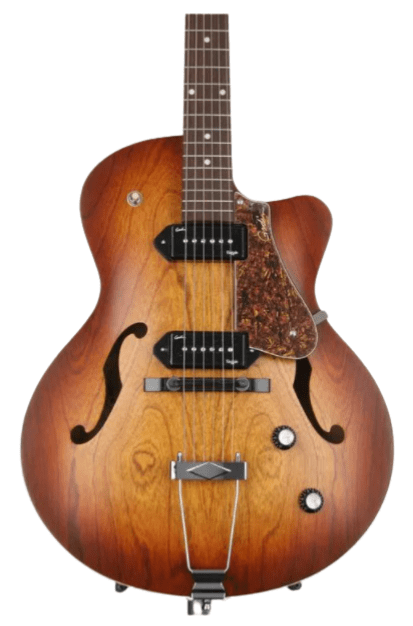
Godin 5th Avenue CW Kingpin II P90
Vintage styling with a surprisingly dynamic tonal range.
To look at this guitar you might think it was all about mellow jazz tones, but the P90s in this thing can really scream when the gain is cranked. This is a beautifully made guitar, and absolutely stands out from the crowd.
Laminated archtops aren’t for everyone. However, for those who need a versatile and sweet-sounding electro-acoustic archtop, the Godin 5th Avenue is – as the name suggests – the Kingpin. The guitar is available in four finish options: Black, Natural, Burgundy, and Cognac Burst.
Kingpin guitars debuted as a ’50s-style molded archtop for jazz enthusiasts and old-style music lovers. They gradually evolved, taking the Gibson ES-125 route, into a single-cutaway with dog-ear P90s.
The Kingpin II was crafted with a laminate Canadian Wild Cherry body, f-shaped sound holes, and a 24.84-inch scale length. It featured a Silver Leaf Maple neck with a rosewood fretboard with a 16-inch radius. Other notable features included a double-action truss rod, contoured headstock, adjustable Tusq bridge, chrome tailpiece, and a floating pickguard.
The guitar had exemplary build quality but the frets were relatively small, and the neck position was higher than usual. To its credit, the Cognac burst and ultra-thin gloss made it one of the most gorgeous guitars in the whole roundup.
Plugged in, the Kingpin II had a rounded tone with a smooth-nose attack – which jazz/blues guitar players will adore. There is scope for rock, but as a laminate hollow-body guitar, it’s prone to a midrange honk and feedback issues as the gain goes up.
Overall, the pickups were low-to-moderate output and fairly versatile for an archtop. The control panel featured volume/tone knobs and a 3-way selector to coax some rather sweet and mellow tones out of it.
Verdict: The Godin 5th Avenue Kingpin II is primed for blues and jazz, but as an archtop, it lends rather well to amp-less rhythms as well. It has survived into the hi-tech age due to its characterful tone and vintage styling. The build quality and electronics are fantastic for the price. However, it could greatly benefit from an initial setup.

Gretsch G-2262T Streamliner
Warm tones and fantastic playability.
The combination of the semi hollow mahogany body, with a spruce center block gives an unusual, and quite stunning combination of warmth and clarity, not often found in instruments in this price range. Despite the inherent warmth, this Gretsch will still scream if given the chance.
Gretsch offers a handful of no-frills P90 guitars with old-school ‘soapbar’ mojo. The Gretsch G2622 model is our favorite from their lineup, as it offers great value for the price. Plus, it’s available with or without the Bigsby and features a spruce center block makes it fairly resistant to feedback.
The G2622 featured a laminated maple body with oversized f-holes and a 24.75” scale length. The U-shaped Nato neck was playable and the double cutaway allowed easy access to the higher register. The guitar features a Laurel fingerboard that houses 22 medium-jumbo frets. The art-deco add-ons, aged white binding, and purfling added charm to the vintage styling.
Tone-wise, the G2622T was loud, flamboyant, and had a distinct fullness to it. The output of FideliSonic P-90 pickups was a touch above the rest in this segment. The neck pickup was warm, rounded, and sweet-sounding whereas the bridge pickup brings the bite and twang to the table.
It has a ‘Gretsch-like’ timbre that is hard to dial out throughout the settings. They had warmth, but also deliver a brightness on account of the distinct presence in the treble. This enabled the guitar to sound loud and well-defined even when we pushed it into overdrive. It had a distinct a twang that worked well with country and rockabilly styles, too.
That said, the G2622T isn’t the only Streamliner with P90s. Other options within the $500 to $1,000 price range include the G2655-P90 (without Bigsby) and G655T-P90. We recommend the versions without the Bigsby at this price point, unless you really need the bends and warbles.
Verdict: The Gretsch G2622T-P90 ranks as the best option for those who want a versatile gain-friendly guitar. The build quality, tone, and finish give it a premium feel whereas the charismatic design and relaxed playability make it a shoo-in for Gretsch fans. With or without a Bigsby, it’s a solid option for a P-90 equipped semi-hollow body electric guitar.
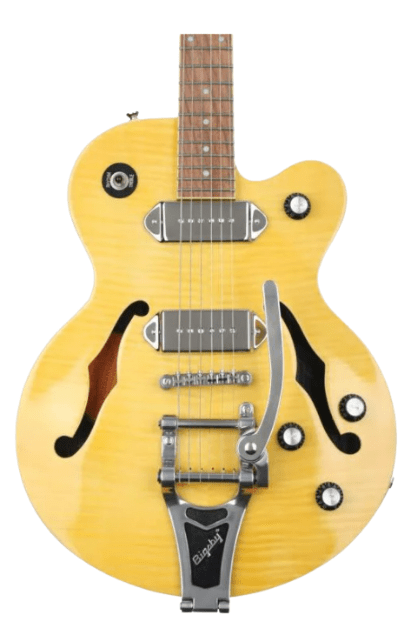
Epiphone Wildkat
One of Epiphone's best known and most loved models.
With this Epiphone, you're getting a real Jekyll and Hyde guitar, one that can flip from soft and mellow to growling high gain overdrive without even breaking a sweat. It's lightweight and comfortable, and it's easily one of the coolest looking guitars out there.
Everyone wrote off the Epiphone Wildkat as a failure when Epiphone announced its launch. The price tag seemed too exorbitant for the features. However, after all these years, the Wildkat is not only time-tested but it’s considered to be one of the best lower-line Epiphone guitars.
The Wildkat had a relatively small mahogany body with a flamed maple veneer that improves the aesthetic more than it impacts the tone. The guitar had an uncommon D-profile tapered neck – the modern flat/oval shape. It was fast under the fingers and extremely easy to handle over extended sessions.
Other important features include a 24.72” scale length, a Bigsby (tremolo), and an Okoume fretboard with 22 medium-jumbo frets. A tremolo bridge can be a hassle even on premium guitars. However, the Wildkat seems to sidesteps the common Bigsby-related concerns unless you go ham on the vibrato for too long.
In terms of electronics, the guitar was equipped with two Epiphone P90R pickups with knobs to tweak individual volume/tone and master volume. The pickups featured braided two-conductor wiring with full wax potting, so they were fairly resistant to feedback.
The P90s sounded snarky with some midrange bite, which is why the guitar works best for blues and rock and roll. It has reasonable sustain, good projection, and a satisfactory range of usable tones. Although not built for it, we were able to sculpt jazzy tones within the largely dark and rounded tonal palette of the instrument.
We found it comfortable to play while sitting or standing. The strings and tuners can be upgraded and the playability may benefit from a good setup. That said, there are no issues with the out-of-the-box string action or intonation.
Verdict: The Wildkat is one of those guitars that liberated Epiphone from being seen as the poor man’s Gibson. There are obvious compromises made to keep the costs low. However, it’s a rugged and well-balanced package in terms of build quality, tone, and aesthetics. If you look at it purely through the prism of price, it packs more value than most other guitars in this roundup.

Guild Aristocrat P90
Stunning finish and exceptional build quality.
This clasy looking guitar might have you thinking it's tame on first impressions, but plug it in and you'll find that it's anything but aristocratic. It's loaded with a pair of hot P90s that sound great in any genre, but really excel with hard rock.
We’ll end our roundup with some respite from the rock and blues machines with a lesser-known P90 guitar – the Guild Aristocrat. The Aristocrat is an inimitable instrument that marries vintage styling to resonant character, yielding a classy instrument with sparkling tones.
The guitar featured a chambered body with a carved spruce top and mahogany back and sides melded with an ivory ABS binding. It was finished with a subtle vintage sunburst and a polyurethane gloss finish.
The glued-in 3-piece mahogany neck had a C-profile with a 12” radius and a Pau Ferro fingerboard with 22 beefy frets. Other notable features include open-gear tuning machines, a harp tailpiece, and a nickel-plated tune-o-matic bridge.
The guitar was ergonomic, light as a feather, and very comfortable for long sets. Its visual appeal was complemented by Franz P90 soapbars that are sonically flexible and pleasantly unrefined. While it can flex its muscle when teamed with a high-gain amp, it’s best used for sweet blues or smooth jazz playing. The neck pickup was warm and the bridge pickup sounded tight but airy.
There is, without doubt, something unique about the tone of this single-cut guitar with a harp tailpiece. It doesn’t compete with the solid body or semi-hollow body instruments but heads off into an acoustic-like realm that is best described as raw/roots-y, with a mid-spike at the right spot.
Verdict: The Guild Aristocrat P90 is a horse of a different color. It’s a whole new shade of P90 that’s miles apart from the usual fare of rock/blues instruments. Besides being the perfect size and weight, Guild has also nailed the right amount of art-deco. It’s worth checking out if you like a vintage-looking single-cut with its own persona and texture.
How to Choose The Right Guitar For You
Not all P90 equipped guitars are created equal. If you’re new to these pickups, you’ll need to know what to look for when shopping for your guitar.
Body Style
P90 pickups are available on basically every guitar body style.
Solid Body
Solid body P90 guitars tend to have the most sustain of all. They offer the best resistance to the unwanted feedback that can plague other styles, and are available in everything from Telecaster style bodies to Les Pauls and SGs.
Semi Hollow Body
Semi hollow body guitars with P90s tend to be a great choice for blues and blues rock in particular. They offer a more rounded, natural tone than solid body guitars, and maintain some of the focus and sustain in the process.
Hollow Body
Hollow body guitars have a ton of great natural acoustic resonance, with a big bottom end that pairs fantastically with P90 pickups. The majority of these models are best suited to low gain music styles, as the feedback can be particularly hard to control.
Single or Double Pickup
P90 guitars are typically available with either 1 or 2 pickups. With 1 pickup you’ll notice a tighter, more focused tone as the reduced magnetic pull on the strings will allow them to vibrate more freely when strummed.
Guitars with 2 P90s might not be so tightly focused, but they gain significant tonal variety, as players can choose between neck, bridge, and in between positions.
Soapbar or Dogear
There are 2 main aesthetics when it comes to P90 pickups: soapbar style and dogear. Soapbar pickups have a distinctive plastic cover with distinctly rounded corners, making it look like a bar of soap.
Dogear-style P90s have one squared-off edge and one triangular edge. It’s this triangular edge that looks somewhat like a dog’s ear, giving this style its name.
The choice between soapbar and dogear is mainly a style thing. There is no noticeable difference when it comes to tone and performance.
Final Thoughts
P90 guitars are incredibly simple, but nevertheless versatile. Their midrange emphasis makes them incredibly capable when it comes to both intricate solos and full-throttle rhythm playing. Whether you want a rough and ready rock instrument or thick bluesy sounds, we’ve shared a broad selection for you to consider.
To recap our top choices for the Best P90 Guitars…
If you want the best balance of price and features, take a look at our Top Pick, the Fender Noventa Telecaster. For a great, but affordable P90 guitar, check out our Best Budget option, the G&L ASAT Junior II. And finally, if money is no object, check out our Editor’s Choice, the Gibson Les Paul Special.
Check out these other articles you might like:

